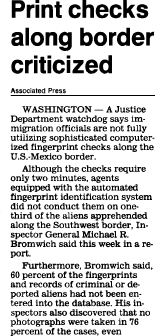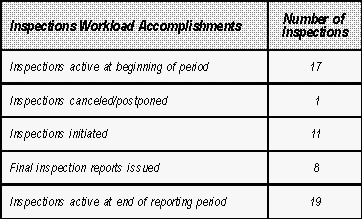
USDOJ/OIG - Semiannual Report to Congress, October 1, 1997 - March 31, 1998 |
Page 28 |
The Inspections DivisionThe Inspections Division assesses Department programs and activities and makes recommendations to decisionmakers for improvements in Department programs, policies, and procedures. |
USDOJ/OIG - Semiannual Report to Congress, October 1, 1997 - March 31, 1998 |
Page 29 |
Inspections Division
The Inspections Division (Inspections) provides the Inspector General
with an alternative mechanism to traditional audit and investigative techniques to assess
Department of Justice (Department) programs and activities. Inspections conducts analyses
and makes recommendations to decisionmakers for improvements in Department programs,
policies, and procedures. Inspections' strength lies in its multidisciplinary workforce
and the ability to quickly address diverse issues. In addition to assessing Department
programs, Inspections also conducts special reviews -- assignments requiring immediate
action -- that are generally initiated at the request of senior Department management or
by Congress.
During this reporting period, Inspections assessed the Immigration and Naturalization
Service's (INS) Automated Biometric Identification System and its effectiveness as a tool
for border enforcement, analyzed INS' Controls Over Certificates of Naturalization from
point of receipt to issuance to qualified aliens, assessed whether the Tri-State Violent
Crime Task Force (VCTF) of the U.S. Attorney's Office for the District of Maryland
(USAO/MD) was meeting its objectives and expending funds for approved purposes, and
conducted reviews of Violent Offender Incarceration and Truth-In-Sentencing (VOI/TIS)
Incentive Grant Programs.
INS' Automated Biometric Identification System
Inspectors examined INS' use of an automated biometric (fingerprint) identification system (IDENT) to help stem the flow of illegal aliens along the U.S.-Mexico border, especially the reentry of criminal aliens and repeat crossers. INS has given a high priority to IDENT deployment at Border Patrol facilities in the Southwest, and it expects that IDENT and related biometric technologies will be useful in many other INS operations.
Our inspection found that there has been limited progress integrating biometrics into INS operations. Even in the Border Patrol, where there has been notable progress in using IDENT, INS is not yet making consistent and effective use of IDENT as a tool for border enforcement. We found that:
· INS is entering into IDENT the records of less than two-thirds of aliens apprehended along the U.S.-Mexico border.
· INS has entered into IDENT the fingerprints of only 41 percent of the aliens deported and excluded in Fiscal Year (FY) 1996; of these, only 24 percent had accompanying photographs, although INS relies on the photograph to confirm identification.
· Only the U.S. Attorney for the Southern District of California had made significant progress in using IDENT systematically to identify and focus prosecutorial resources on the worst offenders.
The Cincinnati Post, Friday, March 27, 1998

We recommended steps that INS needs to take to improve its use of
USDOJ/OIG - Semiannual Report to Congress, October 1, 1997 - March 31, 1998 |
Page 30 |
Significant Inspections
IDENT along the U.S.-Mexico border. Further, we suggested that INS work more closely with
the U.S. Attorney for each district along the border to integrate IDENT into a
comprehensive strategy for battling illegal immigration.
Controls Over Certificates of Naturalization (Phase I)
We issued the first of two reports assessing INS management controls over Certificates of Naturalization (N-550s). Phase I addressed management controls over N-550s at INS' Forms Centers. Because of the N-550's intrinsic value, INS classifies it as a secure document that requires special handling and safeguarding.
Our inspectors found that each Forms Center created electronic inventory spreadsheets to account for N-550s. However, these automation enhancements did not contain the necessary controls to prevent unauthorized record changes. We also found no evidence that independent physical inventories, required to verify the number of N-550s on hand, had been conducted since 1993. In addition, the lack of regular inventories and the Forms Centers' failure to consistently follow established procedures to verify and reconcile shipments to INS field locations left the N-550s vulnerable to loss, theft, or misuse.
Following issuance of our draft report, INS classified the control over N-550s as a material weakness. Our report contained recommendations that, when implemented, should greatly enhance INS' capability to properly account for N-550s.
Tri-State Violent Crime Task Force of the U.S. Attorney' s Office
for the District of Maryland
At the request of the Executive Office for U.S. Attorneys (EOUSA), we conducted the first in a series of inspections of EOUSA's VCTF program. We found that the U.S. Attorney's Office for the District of Maryland (USAO/MD) and the Drug Enforcement Administration had achieved their goal of forming a Tri-State VCTF of federal, state, and local law enforcement officers to investigate violent drug trafficking organizations in Western Maryland, the West Virginia Panhandle, and Northwestern Virginia. The Tri-State VCTF successfully investigated, arrested, and seized assets of violent drug traffickers in the Tri-State area.
However, some of the task force participants were not kept informed of the task force's activities and accomplishments. The USAO/MD had not met with federal, state, and local officials participating in the Tri-State VCTF to assess the feasibility of continuing the task force as a fully funded project after the award money is expended. The financial controls for the approval and payment of overtime to state and local police officers could be improved, and the program oversight responsibilities of the USAO/MD were not clearly identified in EOUSA guidance.
USDOJ/OIG - Semiannual Report to Congress, October 1, 1997 - March 31, 1998 |
Page 31 |
Significant Inspections
We recommended that EOUSA require USAO/MD to:· Establish procedures to inform all Tri-State VCTF participants of task force activities.
· Meet with state and local participants to assess the feasibility of continuing the task force as a fully funded project.
· Strengthen internal controls for overtime payments.
We also recommended that EOUSA:
· Define the roles and responsibilities of USAO/MD in the Tri-State VCTF.
· Issue guidance that establishes a clear and meaningful designation of accountability.
INS' Immigration Officer Training
During FYs 1996 and 1997, INS faced the challenge of hiring record numbers of new immigration officers and Border Patrol agents. We initiated an inspection to determine whether INS' training program had the capacity to train nearly 3,800 immigration officers.
Use of an adjunct training site in Charleston, South Carolina, and development of exportable training enabled INS to increase its training capacity and provide basic training for substantially all of the new immigration officers.
We concluded that INS took risks by not providing law enforcement training, including weapons instruction and qualification, to immigration officers trained at the Charleston facility. For a limited time, partially trained, unarmed officers were assigned to jobs normally performed by armed officers. We also found that INS had not provided General Arrest Authority training as mandated by the Immigration Act of 1990. Immigration officer basic training curricula validations had been neglected, and exportable training courses needed more INS headquarters oversight to ensure consistency and quality.
We recommended that INS begin the necessary General Arrest Authority training by the end of FY 1998, issue procedures that clearly assign authority and responsibility for oversight of exportable basic training programs, and validate basic training curricula, including thoroughly assessing the Spanish language needs of each type of immigration officer.
Ammunition Storage at INS Facilities
While performing the Controls Over Certificates of Naturalization inspection, inspectors identified a potential safety hazard regarding the storage of large quantities of ammunition at an INS district office facility. A team was assigned to determine the regulations that govern safe and secure storage of ammunition.
USDOJ/OIG - Semiannual Report to Congress, October 1, 1997 - March 31, 1998 |
Page 32 |
Significant Inspections
We found that INS ammunition storage facilities must comply with Title 29 of the Code
of Federal Regulations, Section 1910.109(j), Occupational Safety and Health
Administration regulations for explosives and blasting agents. These regulations, though
mandatory, are not included in INS' firearms policy. We also found that no Department
standards exist and that INS' firearms policy includes minimal guidance on ammunition
storage.
We recommended that INS include Section 1910.109(j) in its firearms policy to ensure that officials at all ammunition storage locations comply with these standards and that INS periodically review compliance with ammunition regulations.
Violent Offender Incarceration and Truth-In-Sentencing
Incentive Grant Program
Under the Violent Crime Control and Law Enforcement Act of 1994, formula grant funding is awarded to eligible states to build or expand correctional facilities to increase secure confinement space for violent offenders. Inspectors conduct site reviews of grant recipients to ensure that they are achieving program objectives and federal funds are spent in accordance with program requirements. During this reporting period, we completed reviews for Mississippi, Georgia, Florida, and Indiana.
Our reviews found that the states were either in the early phases of planning their
VOI/TIS projects or did not plan to begin new construction or renovation projects until
all federal and state funds for the projects were available. We found that, although grant
funds have not been expended, preliminary or proposed project budgets included some
construction costs that were unrelated to increasing bed space for violent offenders or
were for prohibited items such as furniture and vehicles. We asked the Office of Justice
Programs to review individual state project reports and budgets to ensure funds will be
used for intended purposes.
INS' Monitoring of Nonimmigrant Overstays
In our last Semiannual Report to Congress, we reported on our inspection of INS' Monitoring of Nonimmigrant Overstays. Our report findings indicated that INS had insufficient systems to compile information on the overstay population and lacked an enforcement policy that specifically targets the overstay population. Since the report, INS has classified the overstay problem as a material weakness and established milestones for correcting the overstay problem.
USDOJ/OIG - Semiannual Report to Congress, October 1, 1997 - March 31, 1998 |
Page 33 |
The chart below summarizes Inspections' workload accomplishments for the 6-month reporting
period ending March 31, 1998.
